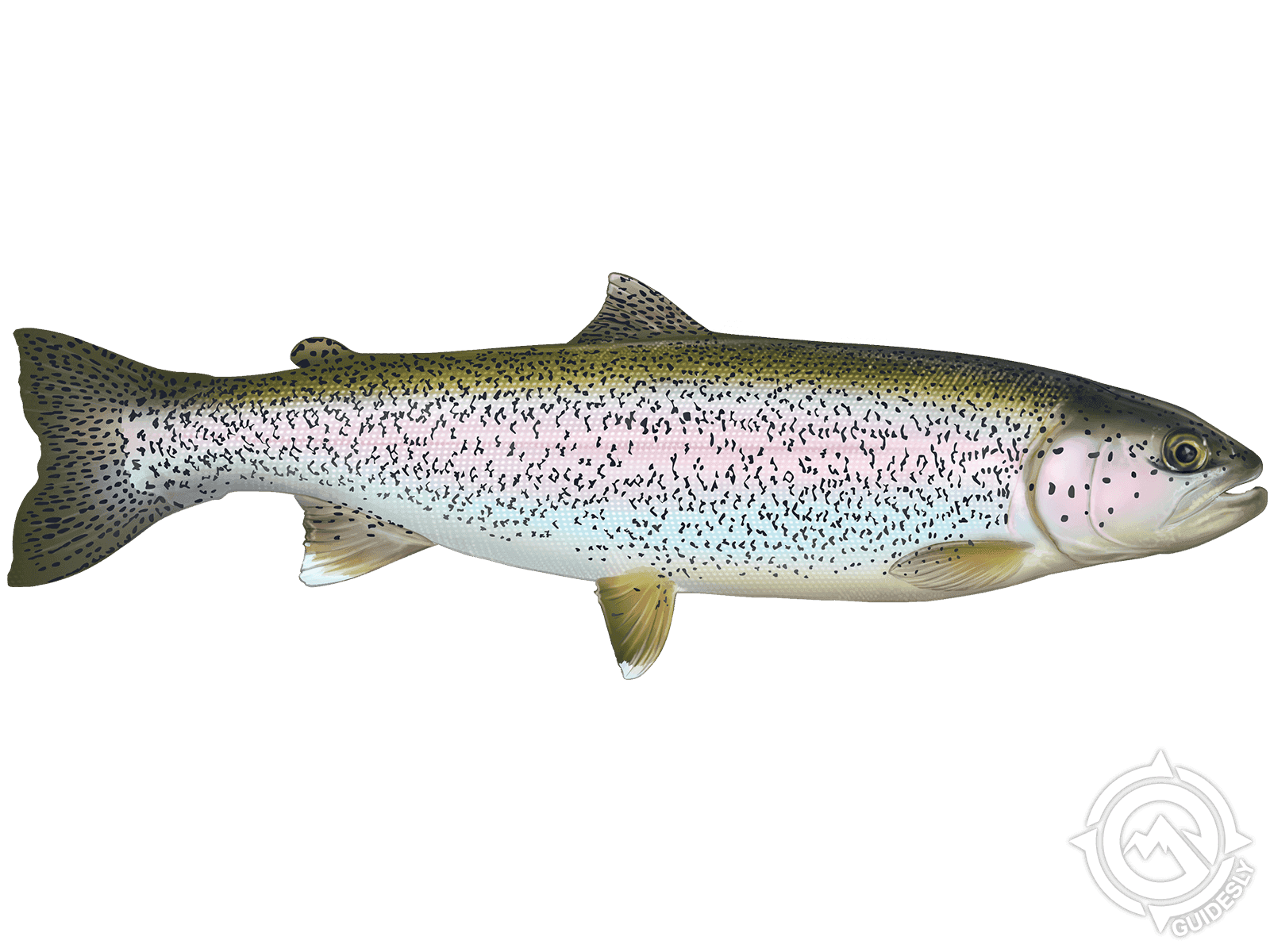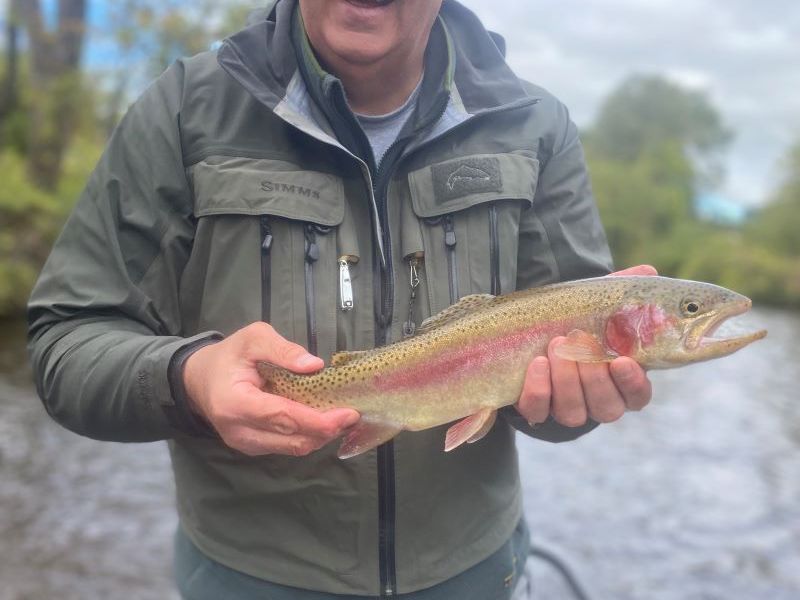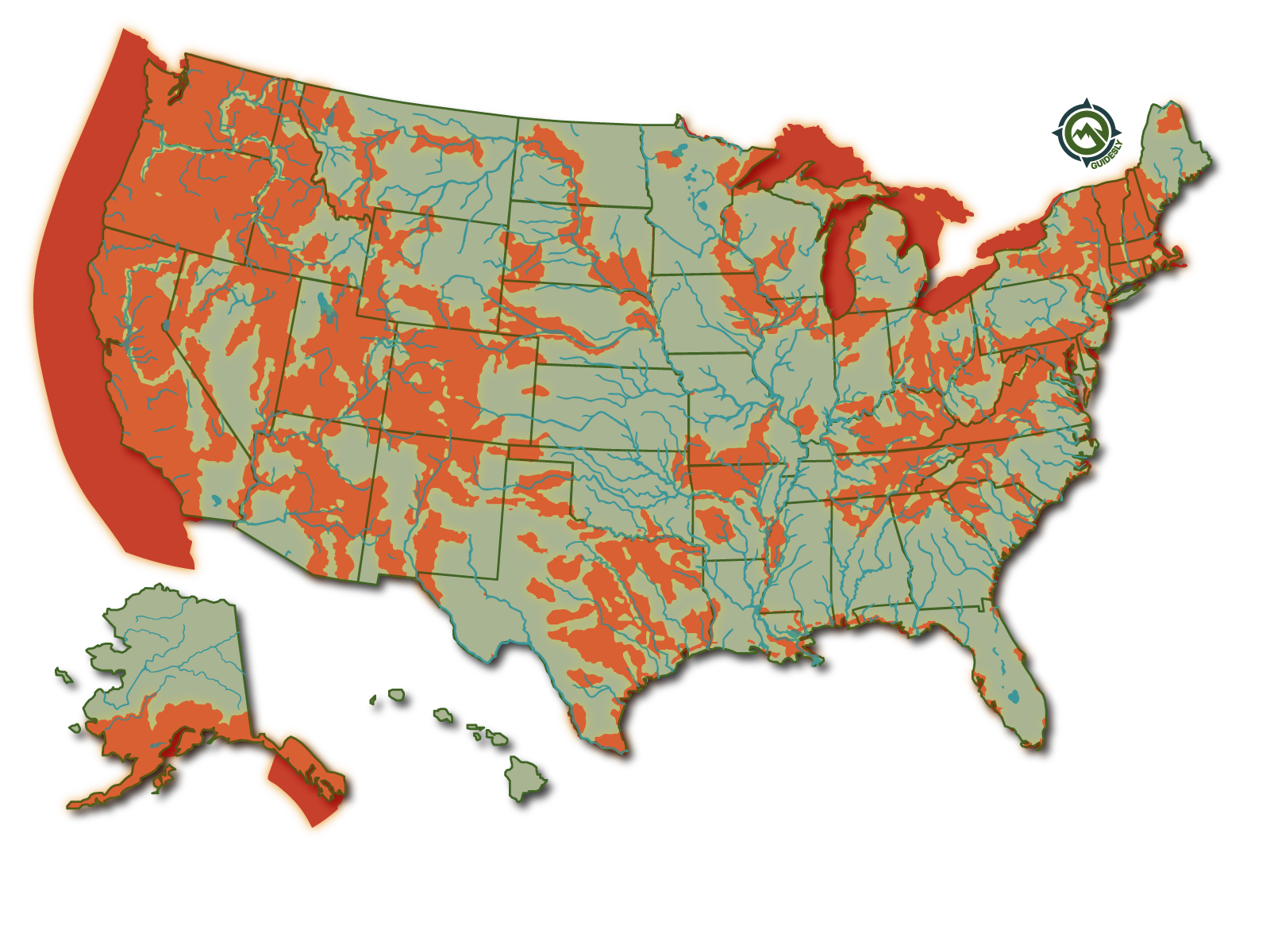Rainbow Trout

Species Details
Oncorhynchus Mykiss
Salmonidae
Salmoniformes
River, Lake
1 - 8 lbs.
16" - 34"
What is the Rainbow Trout Fish?
The rainbow trout is a popular freshwater gamefish in the US. Its name comes from its attractive color—a pinkish horizontal line on its sides and bluish-green to olive-green on the upper part of its body. It is mostly found in flowing waters with natural covers such as water vegetation, weeds, and gravelly shoreline.
Rainbow Trout (Oncorhynchus Mykiss)
Description
Rainbow trout is a popular game fish known for its attractive color and ability to swim upstream. It belongs to the Salmonidae family. The upper body color ranges from bluish-green to olive green. They are silver to white in color near the belly. A horizontal pink stripe is present on each side of the body. The body is covered with black spots and extend to dorsal fins, tail, and anal fins. The appearance of a rainbow trout can depend on habitat, gender, age, and maturity.

Interesting Facts
- Rainbow trout starts spawning at age of 3 or 4 years.
- They have a life span of 4-8 years but can live up to 11 years as well.
- As this species can only live in clean water, they are very good indicators of pollution.
- A water temperature of 55°F to 64°F is preferred by the rainbow trout, but they can also survive up to 70 °F.
Habitat, Distribution and Heat Map

Rainbow Trout is native of the United States including the Pacific coast from Mexico to Alaska, northeastern and central United States along with the eastern coast of Asia.
Rainbow trout can be found in freshwater bodies such as rivers and streams. They prefer a place with an abundance of natural covers such as water vegetation, weeds, and gravelly shoreline. Rainbow trout can be found in streams where the currents are strong and water flow is fast but also do well in cool and deep water.
Rainbow Trout Spawning
The spawning season starts in late winter or early spring and can go through early summer as well. During this time, the male Rainbow trout finds a shallow place with gravels or a clear water inlet/outlet. The female lays eggs there. Depending on the water temperature, hatching takes a few weeks to 4 months. After hatching, they keep themselves in hiding until they reach 2 to 3 years and then go into deep waters.
Other names include steelhead, red-sides, River trout, and silver trout. Rainbow Trout are predators and mostly feed on insects, small fish, and crustaceans. They also eat eggs, other rainbow trout, and even feast on leftover carcasses.
Rainbow Trout Size and Weight
A Rainbow trout can vary in length from 8 inches to 24 inches. The largest Rainbow trout was fished in Canada in 2009 and weighed 48 pounds. The average weight of the species is from 2 to 8 pounds.
Is Rainbow Trout Good to Eat?
Rainbow trout is a popular fish among anglers and food enthusiasts alike. It has a distinct pink flesh that can be enjoyed in many different dishes.
Cooking rainbow trout can be done using various methods such as grilling, baking, or frying. When cooked properly, it offers a delicious and healthy meal option for those who enjoy seafood. The taste of rainbow trout is often described as mild with a slightly nutty flavor that pairs well with herbs like thyme or rosemary.
Rainbow trout contains high levels of omega-3 fatty acids which are essential for maintaining good health. These fatty acids have been linked to reducing the risk of heart disease and improving brain function.
Fishing Techniques - How to Catch a Rainbow Trout
They can be found near gravelly shorelines in the river, or in a downstream flow. In summer, they go to cooler depths. It is recommended to fish rainbow trout during their feeding time, which can be at dusk or late evening. Best fishing techniques include:
- Nymphing fly fishing
- Dry fly fishing for rising fish
- Emergers & Buggers fly fishing
- Keeping bait off the bottom
- Retrieving a bait
- Hanging lure below a bobber
- Drifting an artificial lure
Fly Fishing for Rainbow Trout
Fly fishing for rainbow trout is a thrilling and rewarding experience that many anglers dream of. Rainbow trout are one of the most popular game fish in North America, and fly fishing for them can be both challenging and exciting. Whether you are an experienced angler or new to the sport, fly fishing for rainbow trout is an activity that should be on your bucket list.
To successfully fly fish for rainbow trout, it's important to understand their behavior and habitat. These fish prefer clear, cold water with good oxygen levels, so look for rivers or streams with these conditions. Rainbow trout also tend to feed on insects near the surface of the water, so using dry flies can prove effective. When choosing your equipment, consider using a lightweight rod between 7-9 feet in length with a weight rating of 3-5.
If you want to learn more about rainbow trout fly fishing, check the Guidesly Nymph Series of articles. Start with an introduction and progress thru techniques, tactics, flies, and trends.
- Introduction to Nymphing, Learn what is Nymphing, the art of fly fishing with a nymph
- Basic Techniques of Nymphing, Learn the basic techniques involved with nymphing
- Advanced Nymphing, Discuss the details of nymphing techniques
- Top 10 Nymph Flies, See the top 10 nymph flies with fly-tying videos
- Euro Nymphing, The latest trend in nymphing is European-style nymphing.
- Trout of North America, Find your nymphing prey. Learn about the top 10 trout species in North America.
Rainbow Trout Baits and Lures
Common baits and lures for rainbow trout are:
- Spoons
- Spinners
- Plugs
- Worms
- Flies
- Roe
- Egg sac
What is the Difference Between Rainbow Trout & Steelhead Trout?
The key difference between rainbow trout and steelhead is where they live. They are actually the same species of trout and in many cases look very similar. A rainbow trout will stay in freshwater streams. The steelhead trout will leave freshwater and spend a portion of its life in saltwater until returning to its freshwater spawning grounds to breed. Steelhead can also be seen in great numbers in the Great Lakes and migrating, spawning in the many tributaries.
What is Special About the Rainbow Trout?
The rainbow trout are indeed special and hold a special allure to fly fishing anglers around the globe. Rainbow trout are native to the United States and specifically west of the Mississippi River, primarily in the pacific northwest. Their distinctive pink, red and purple stripes along the sides of their silvery bodies make them easily recognizable. But what makes rainbow trout so special? There are several key factors that set them apart from other fish.
- Rainbow trout have an incredible ability to adapt to different environments. They can thrive in both freshwater and saltwater habitats, which is rare among fish species. This means they can be found in lakes, rivers, streams and even in the ocean.
- Rainbow trout have a well-deserved reputation for being strong fighters when caught on a fishing line. They are known for their acrobatic jumps and sudden bursts of energy that challenge even the most experienced anglers.
- They are often found in majestic rivers across the United States that are among the most beautiful places to visit. Fly fishing in the middle of nature if often therapeutic to the angler.
- Rainbow trout have been stocked in great numbers across the United States so almost every river and lake will have some rainbow trout. Many rivers have large populations after stocking introduction.
A Brief History of Rainbow Trout
Rainbow trout has a long and fascinating history. Rainbow trout has a rich history, dating back to the late 1800s when it was first introduced to North America from Europe. Belonging to the salmon family, it has been present on Earth for thousands of years. This species of fish is native to several regions of North America, as well as Eurasia, making it a versatile and widely found fish. Interestingly, the upper Columbia River was where scientists first described it to the scientific community in 1836.
North American Trout Family
Trout are members of the family Salmonidae, order Salmoniformes. The native trout family is closely related to salmon. A top fly fishing family of fish that are both tremendous game fish and tasty eating fish. Found in small streams, large rivers, and any trout stream with the right water temperature, aquatic insects, and clean water. The trout species is usually restricted to freshwater, though a few types migrate to the sea between spawnings.
The Trout Species in North America:
- Rainbow Trout
- Brown Trout
- Brook Trout
- Lake Trout
- Steelhead Trout
- Bull Trout
- Cutthroat Trout (several species of cutthroat)
- Apache Trout







